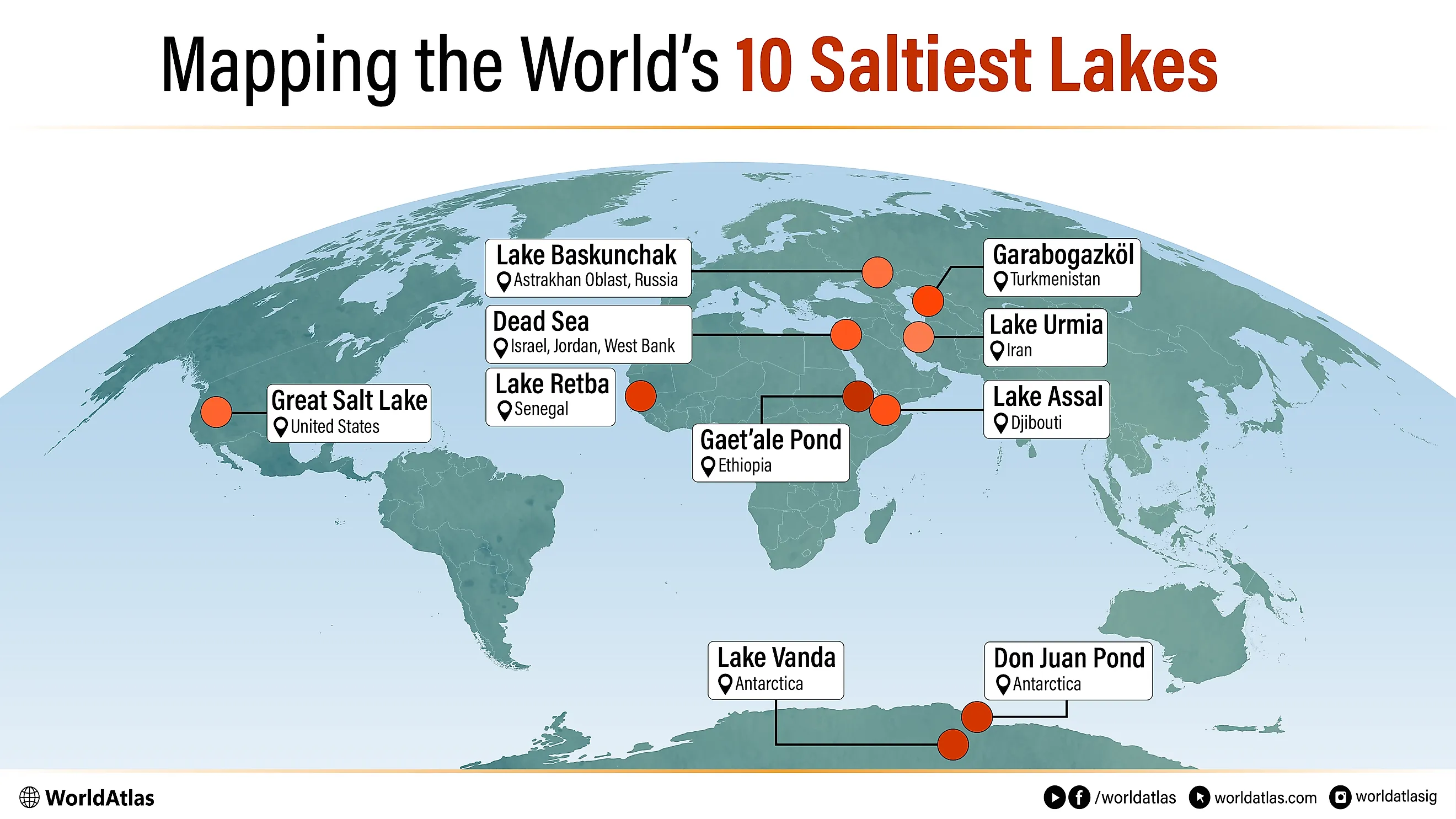
The 10 Saltiest Lakes in the World
Most people assume the Dead Sea is the saltiest lake on Earth. It isn’t. That title currently goes to Gaet’ale Pond in Ethiopia, a tiny, scalding hot pool with around 433 g/L of dissolved salts - far above the Dead Sea’s 337 g/L. Based on best-available estimates of peak salinity, the 10 saltiest lakes in the world are: Gaet’ale Pond, Don Juan Pond, Lake Retba, Lake Vanda, Garabogazköl, Lake Assal, the Dead Sea, the Great Salt Lake (north arm), Lake Baskunchak, and Lake Urmia.
This ranking, however, is less simple than it looks. Some of these "lakes" are small, unstable ponds where conditions can change dramatically after an earthquake, flood, or drought. Others are vast basins split into separate arms with very different salinities, or are shrinking so fast that any single number is a moving target. A few are industrial landscapes, mined for millions of tonnes of salt; others are critical habitats on the brink of ecological collapse.
The 10 Saltiest Lakes In The World
| Rank | Lake | Salinity (g/L, approx) | Location |
|---|---|---|---|
| 1 | Gaet'ale Pond | 433 | Ethiopia |
| 2 (tie) | Don Juan Pond | 400 | Antarctica |
| 2 (tie) | Lake Retba | 400 | Senegal |
| 4 (tie) | Lake Vanda | 350 | Antarctica |
| 4 (tie) | Garabogazkol | 350 | Turkmenistan |
| 6 | Lake Assal | 348 | Djibouti |
| 7 | Dead Sea | 337 | |
| 8 | Great Salt Lake, North Arm | 317 | United States |
| 9 | Lake Baskunchak | 300 |
Astrakhan Oblast, Russia
|
| 10 | Lake Urmia | 120-380 | Iran |
1. Gaet'ale Pond - 433 g/L
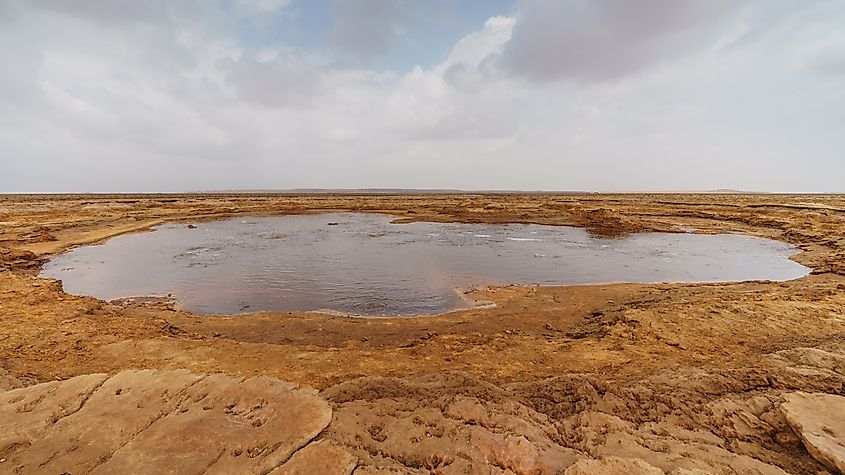
Gaet’ale Pond, in Ethiopia’s Danakil Depression, is a tiny hypersaline lake widely regarded as the saltiest body of water on Earth. Fed by a reactivated tectonic hot spring after a 2005 earthquake, it has no inlet or outlet and reaches a staggering 43% salinity (about 433 g/kg). The crescent-shaped pool is only about 60 metres across, yet its 50-55 °C waters are loaded with calcium and magnesium chlorides, stained yellow by trace iron. Odourless volcanic carbon dioxide bubbles from the surface, and nearby bird and insect carcasses highlight the site’s potentially lethal, if visually striking, conditions.
2. Don Juan Pond - 400 g/L (tie)
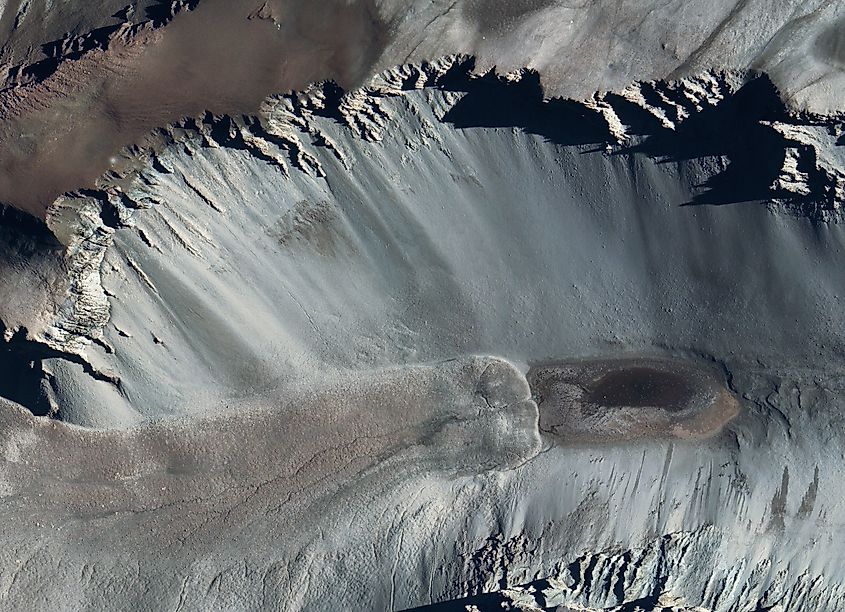
Don Juan Pond is a tiny, ultra-salty lake in Antarctica’s Wright Valley and one of the saltiest natural waters on Earth. With salinity reaching around 46%, its calcium-chloride brine is even saltier than the Dead Sea and most other hypersaline lakes. This extreme chemistry keeps the pond liquid at temperatures as low as −50 °C, so it rarely, if ever, freezes. Fed by brines seeping through surrounding soils and possibly deeper groundwater, the pond shrinks and expands over time. Despite its harsh conditions, Don Juan Pond hosts a sparse community of hardy microbes adapted to this remarkably briny polar environment.
2. Lake Retba - 400 g/L (tie)

Lake Retba, or Lac Rose, is a small hypersaline lake on Senegal’s Cap Vert Peninsula, famed for its vivid pink colour created by Dunaliella salina algae. With salt concentrations reaching about 40%, its buoyant waters rival other famous salt lakes and support a major artisanal salt industry. Around 3,000 workers harvest tens of thousands of tonnes each year, protecting their skin with shea butter as they wade through the brine. Severe flooding in 2022 briefly stripped the lake of its colour and damaged salt piles, but by 2025 it had partially recovered and remains a candidate UNESCO World Heritage Site.
4. Lake Vanda - 350 g/L (tie)
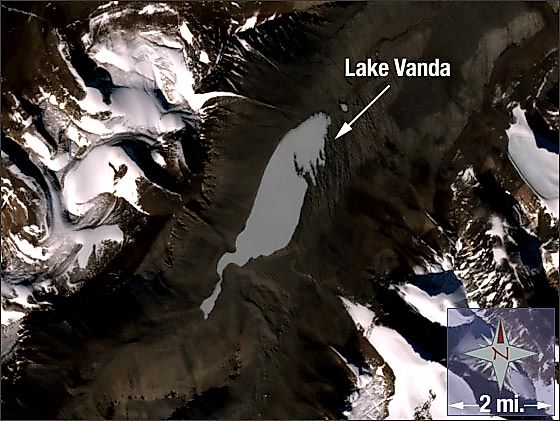
Lake Vanda is a hypersaline lake in Antarctica’s Wright Valley, famous for having bottom waters over ten times saltier than seawater and even saltier than the Dead Sea. Permanently capped by 3-4 metres of clear ice, it is meromictic, with three distinct, non-mixing layers ranging from near-freezing at the surface to about 23 °C at depth. The ultra-salty deep layer forms one of the most extreme aquatic environments on Earth, yet still hosts microbial life. Fed by the Onyx River, Antarctica’s longest river, Lake Vanda has become an important modern natural laboratory for climate, polar desert, and microbial ecology research.
4. Garabogazkol - 350 g/L (tie)

Garabogazkol, a vast hypersaline lagoon on Turkmenistan’s Caspian Sea coast, is one of the world’s saltiest large water bodies, with average salinity around 35%, over ten times that of the open ocean. Shallow but sprawling, it’s fed through a narrow strait from the Caspian, then concentrated by intense evaporation into huge natural salt pans. Industrial salt extraction has operated here since the Soviet era, including groundwater pumping for high-value salts. In 1980 the strait was dammed, and the lagoon dried completely by 1984, creating a windblown "salt bowl" disaster, before being reflooded in 1992 when the barrier was removed.
6. Lake Assal - 348 g/L
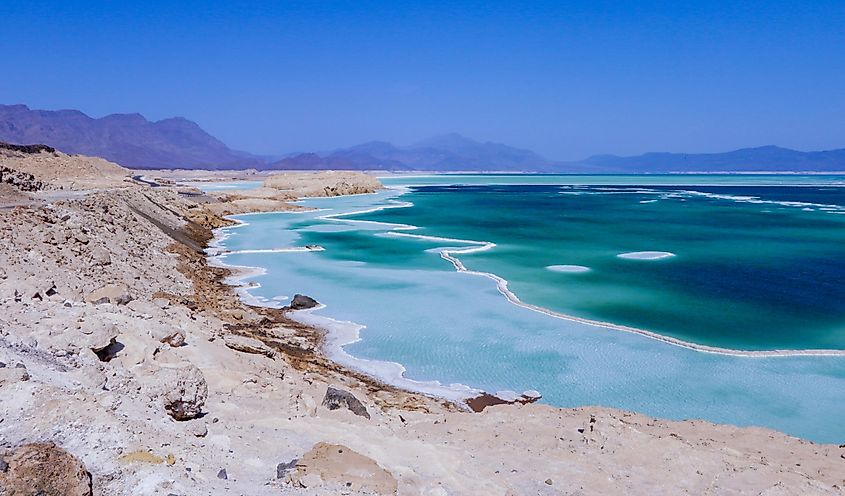
Lake Assal in central-western Djibouti is a crater lake in the Afar Triangle, lying 155 m below sea level, the lowest point in Africa. With salinity around ten times that of seawater and up to about 35-40% salt, it ranks among the world’s saltiest lakes. Fed mainly by subsurface inflow from the nearby Gulf of Tadjoura and losing water only through intense evaporation, it forms vast salt crusts rich in NaCl. For centuries Afar caravans traded its "white gold"; today large industrial concessions mine millions of tonnes yearly, while the area is proposed as a UNESCO World Heritage Site for protection.
7. Dead Sea - 337 g/L
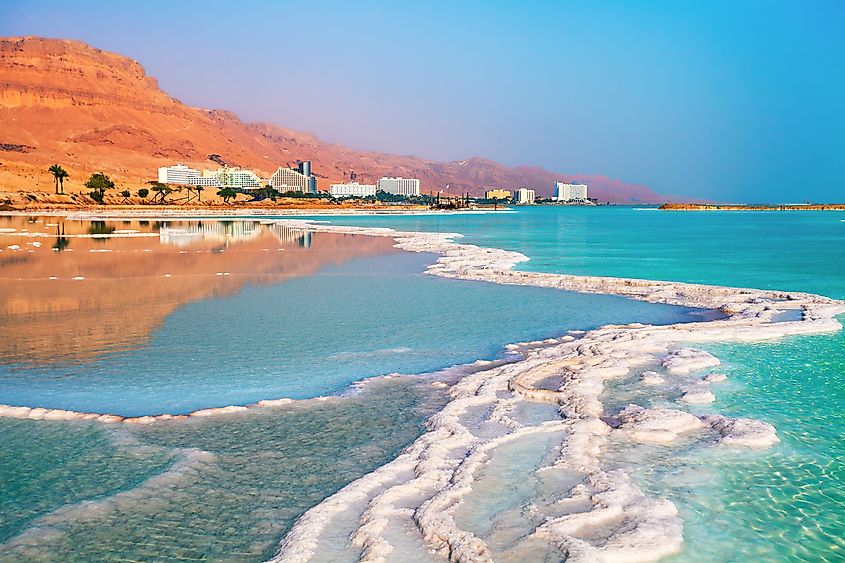
The Dead Sea, shared by Jordan, Israel and the Israeli-occupied West Bank, is one of the world’s saltiest lakes, with salinity around 34%, almost ten times that of the ocean. Lying about 440 metres below sea level, it is both the deepest hypersaline lake and the lowest exposed point on Earth. Its dense water lets visitors float effortlessly, while its mineral-rich brine and mud support a major spa and cosmetics industry. Historically prized for asphalt and potash, the Dead Sea now faces rapid shrinkage due to water diversion and mineral extraction, driving international efforts to slow its decline.
8. Great Salt Lake, North Arm - 317 g/L
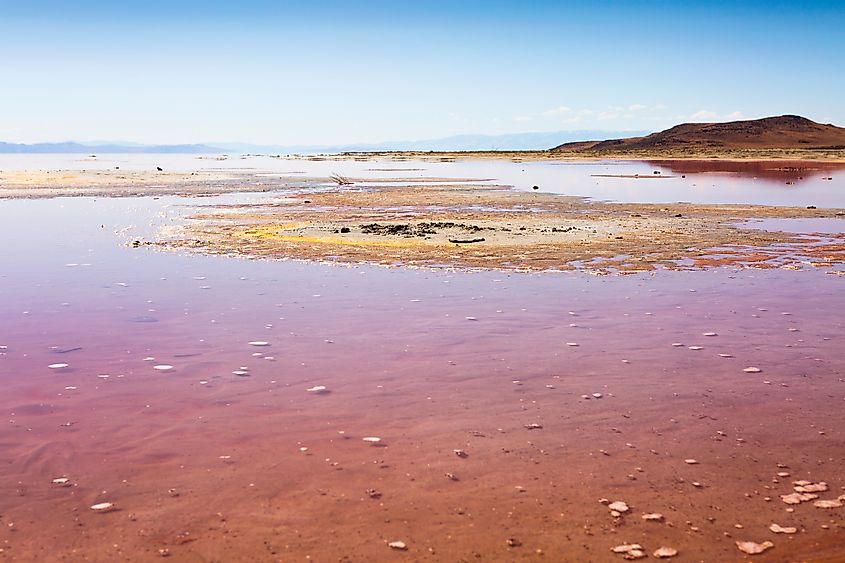
The Great Salt Lake in northern Utah is the largest saltwater lake in the Western Hemisphere and a remnant of ancient Lake Bonneville. Fed by the Bear, Weber and Jordan rivers but with no outlet, it steadily concentrates minerals, making its waters far saltier than the ocean and buoyant enough for effortless floating. Salinity varies with water level, ranging from around 5-15% in the south arm to over 30% in the isolated north arm. Despite its nickname "America’s Dead Sea," the lake supports vast populations of brine shrimp and birds. Severe drought, water diversion and climate change are now shrinking the lake, threatening its ecosystems and turning exposed lakebed into toxic dust.
9. Lake Baskunchak - 300 g/L

Lake Baskunchak, in Russia’s Astrakhan Oblast, is a hypersaline lake lying 21 metres below sea level in the Caspian Depression. Fed by a small river but losing water mainly to evaporation, it reaches salinities of about 300 g/L, placing it among the world’s saltiest lakes. Baskunchak has been mined since the 8th century and today supplies around 80% of Russia’s salt, famed for its 99.8% NaCl purity. Nearby Mount Bolshoye Bogdo, a rising salt dome, adds geological interest, while bromine-rich air, sodium chloride brine, and sulphide muds have made the lake a growing destination for therapeutic tourism.
10. Lake Urmia - 120-180 g/L
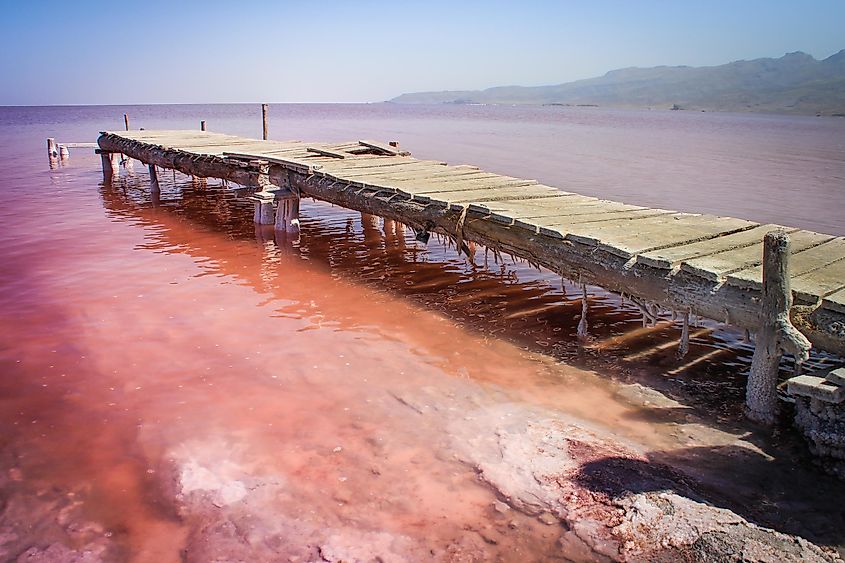
Lake Urmia in northwestern Iran is a vast endorheic salt lake once the largest in the Middle East, reaching about 6,000 km² with salinity up to roughly 28%. Fed by more than a dozen rivers and having no outlet, it has become increasingly hypersaline as dams, groundwater pumping and prolonged drought have slashed its volume and shrunk it to a fraction of its former size, with near-total desiccation in the 2020s. Despite this collapse, the lake and its former islands remain a protected national park and Ramsar / UNESCO Biosphere site, crucial for Artemia and migratory birds like flamingos.
The Saltiest Lakes in the World
| Rank | Lake | Salinity (g/L, approx) | Location |
|---|---|---|---|
| 1 | Gaet'ale Pond | 433 | Ethiopia |
| 2 (tie) | Don Juan Pond | 400 | Antarctica |
| 2 (tie) | Lake Retba | 400 | Senegal |
| 4 (tie) | Lake Vanda | 350 | Antarctica |
| 4 (tie) | Garabogazköl | 350 | Turkmenistan |
| 6 | Lake Assal | 348 | Djibouti |
| 7 | Dead Sea | 337 |
Israel, Jordan, West Bank |
| 8 | Great Salt Lake, North Arm | 317 | United States |
| 9 | Lake Baskunchak | 300 |
Astrakhan Oblast, Russia
|
| 10 | Lake Urmia | 120-380 | Iran |
| 11 | Little Manitou Lake | 180 | Canada |
| 12 | Great Salt Lake, South Arm | 142 | United States |
| 13 | Lake Abert | 120 |
Great Basin, Oregon, United States
|
| 14 | Mono Lake | 88 | United States |
| 15 | Hamelin Pool | 66 | Australia |











